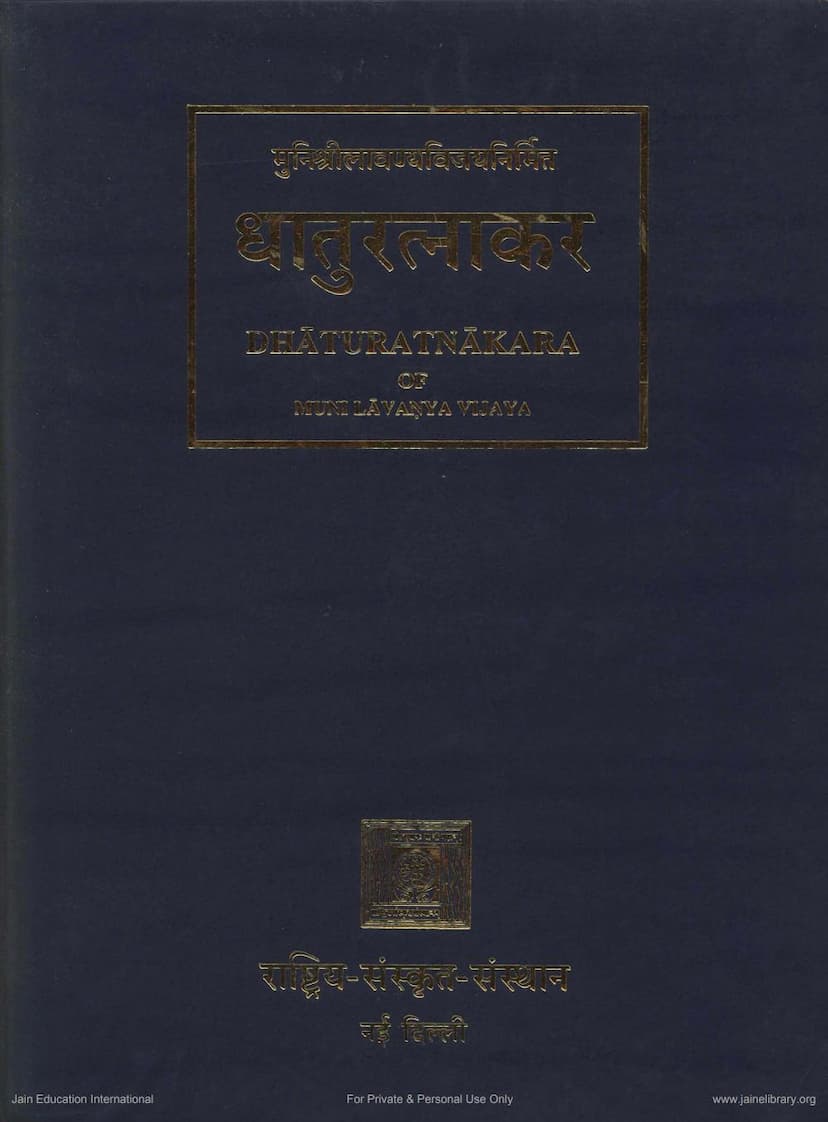Dhaturatnakar Part 3
Added to library: September 1, 2025

Summary
Certainly, here's a comprehensive summary of the Jain text "Dhaturatnakar Part 3" by Lavanyasuri, published by Rashtideya Sanskrit Sansthan, New Delhi, based on the provided text:
Title: Dhaturatnakar Part 3 Author: Muni Lavanyasuri Publisher: Rashtriya Sanskrit Sansthan, New Delhi Catalog Link: https://jainqq.org/explore/001922/1
Overview:
"Dhaturatnakar Part 3" is the third volume of a larger work, "Dhaturatnakar," authored by Muni Lavanya Vijaya Suri. This particular volume, as indicated by its subtitle ("सन्नन्त प्रक्रिया यडन्त प्रक्रिया" - meaning processes related to 'sannanta' and 'yaḍanta' verbal roots), is a comprehensive grammatical treatise. It is a revised edition published by the Rashtriya Sanskrit Sansthan, New Delhi, as part of their re-printing scheme.
Content and Focus:
The primary focus of this volume is the detailed explanation and illustration of "sannanta" and "yaḍanta" forms in Sanskrit grammar, specifically within the context of Jain grammar. These grammatical categories relate to specific verbal conjugations and derivations.
-
Sannanta Process (सन्नन्त प्रक्रिया): This section delves into the formation of verbs that take the "san" (सन) suffix. This suffix generally indicates a desire or intention to perform an action, transforming a verb root into a denominative or causative form. The text meticulously explains the rules and conditions for applying the "san" suffix to various verb roots. It enumerates the roots that are eligible, the changes that occur, and provides numerous examples for each tense and mood. The text seems to follow the principles of Panini's grammar but may incorporate specific interpretations or additions from Jain grammatical traditions. The examples provided cover roots from the 'bhvadi' (भ्वादि) group, which are the most common and fundamental.
-
Yadanta Process (यडन्त प्रक्रिया): While the subtitle mentions "yaḍanta" processes, the bulk of the provided text appears to be dedicated to the "sannanta" forms. It is possible that the "yaḍanta" aspect, which refers to roots taking the "ya" (य) suffix, is either integrated implicitly within the "sannanta" discussion or intended for a different part of the work. The "san" process is crucial for expressing desire and is a significant topic in Sanskrit morphology.
Key Features:
- Comprehensive Root Coverage: The text systematically lists numerous Sanskrit verb roots (dhatus). For each root, it demonstrates the formation of various verbal forms based on the "san" conjugation. This includes different persons, tenses, moods, and voices.
- Detailed Grammatical Analysis: The author provides in-depth explanations of the grammatical rules governing these formations. This includes discussions on specific exceptions, augmentations, and phonetic changes (sandhi) that apply.
- Classical Structure: The work follows a traditional Sanskrit grammatical text structure, starting with foundational rules and progressing to detailed applications with verb root examples.
- Jain Scholarly Tradition: The publication by Rashtriya Sanskrit Sansthan and the authorship by Muni Lavanya Vijaya Suri indicate its grounding in classical Sanskrit learning, potentially with a Jain perspective on grammar. The introductory messages highlight the importance of preserving and making accessible rare Sanskrit texts.
Significance:
"Dhaturatnakar Part 3" serves as a valuable resource for students and scholars of Sanskrit grammar, particularly those interested in verb morphology and the specific conjugations taught within the Jain tradition. It provides a systematic and detailed exploration of "sannanta" verbs, which are essential for a nuanced understanding of Sanskrit expression. The re-printing by a reputable institution ensures its availability for further study and research.
In essence, this volume is a highly technical and detailed grammatical handbook focused on the formation of a specific class of Sanskrit verb forms, crucial for mastering the language from a classical and scholarly perspective.